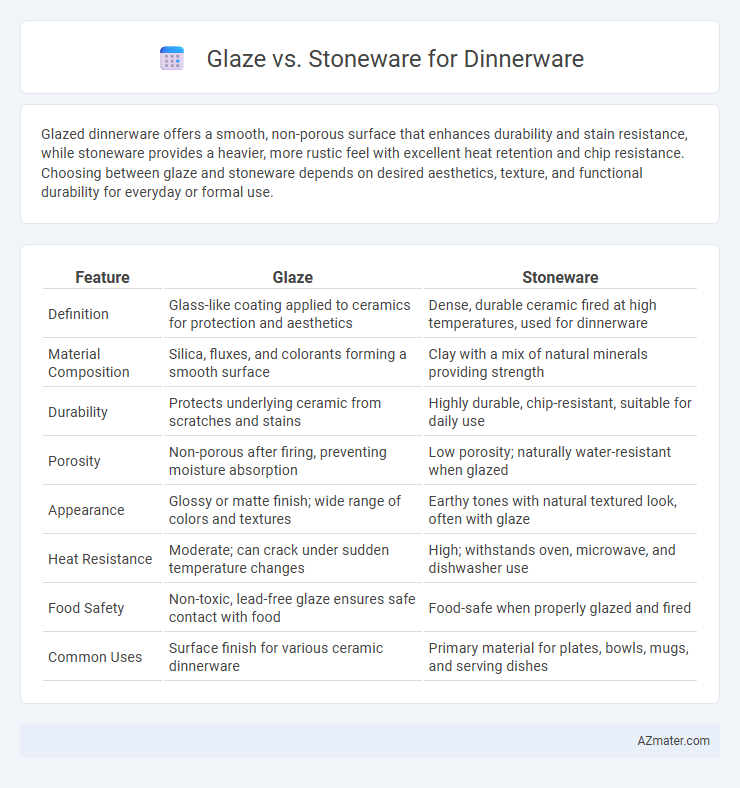Glazed dinnerware offers a smooth, non-porous surface that enhances durability and stain resistance, while stoneware provides a heavier, more rustic feel with excellent heat retention and chip resistance. Choosing between glaze and stoneware depends on desired aesthetics, texture, and functional durability for everyday or formal use.
Table of Comparison
| Feature | Glaze | Stoneware |
|---|---|---|
| Definition | Glass-like coating applied to ceramics for protection and aesthetics | Dense, durable ceramic fired at high temperatures, used for dinnerware |
| Material Composition | Silica, fluxes, and colorants forming a smooth surface | Clay with a mix of natural minerals providing strength |
| Durability | Protects underlying ceramic from scratches and stains | Highly durable, chip-resistant, suitable for daily use |
| Porosity | Non-porous after firing, preventing moisture absorption | Low porosity; naturally water-resistant when glazed |
| Appearance | Glossy or matte finish; wide range of colors and textures | Earthy tones with natural textured look, often with glaze |
| Heat Resistance | Moderate; can crack under sudden temperature changes | High; withstands oven, microwave, and dishwasher use |
| Food Safety | Non-toxic, lead-free glaze ensures safe contact with food | Food-safe when properly glazed and fired |
| Common Uses | Surface finish for various ceramic dinnerware | Primary material for plates, bowls, mugs, and serving dishes |
Introduction to Glaze and Stoneware Dinnerware
Glaze is a glass-like coating applied to stoneware dinnerware, providing a smooth, non-porous surface that enhances durability and aesthetic appeal. Stoneware itself is a type of ceramic fired at high temperatures, known for its strength, chip resistance, and heat retention. Combining glaze with stoneware ensures dinnerware is both functional and visually appealing, making it a popular choice for everyday use and special occasions.
What Is Glaze in Dinnerware?
Glaze in dinnerware is a glassy coating applied to ceramics, providing a smooth, non-porous surface that enhances durability and aesthetic appeal. It seals the stoneware, preventing moisture absorption and making the pieces dishwasher and food safe. This protective layer also allows for vibrant colors and various finishes, distinguishing glazed stoneware from its unglazed counterparts.
Understanding Stoneware: Material and Properties
Stoneware is a dense, non-porous ceramic material fired at high temperatures, typically between 1,200degC and 1,300degC, which gives it exceptional durability and strength. Its natural composition includes clay and other minerals, resulting in a sturdy, chip-resistant product ideal for everyday dinnerware. The glaze applied to stoneware enhances its resistance to stains and moisture while providing a smooth, easily cleanable surface.
Durability: Glaze vs Stoneware
Stoneware boasts exceptional durability due to its dense, non-porous composition fired at high temperatures, making it resistant to chips and cracks. The glaze applied to stoneware enhances its strength by sealing the surface, preventing stains, and adding a protective barrier against everyday wear. While glaze can chip over time if mishandled, the robust nature of stoneware combined with a quality glaze offers long-lasting dinnerware well-suited for frequent use.
Aesthetic Appeal: Colors, Textures, and Finishes
Glaze on dinnerware offers a wide spectrum of vibrant colors and glossy finishes that enhance visual appeal and provide a protective, smooth surface. Stoneware features natural, earthy tones with matte or semi-matte textures, delivering a rustic, tactile experience that highlights handcrafted imperfections. The choice between glaze and stoneware depends on desired aesthetic, with glazed pieces suited for bold, polished looks and stoneware favored for organic, subdued elegance.
Safety and Food Compatibility
Glaze on stoneware dinnerware acts as a non-porous barrier, enhancing safety by preventing food absorption and bacterial growth. High-quality stoneware with FDA-approved glaze ensures resistance to toxins such as lead and cadmium, making it safe for food contact. Choosing properly fired stoneware with certified glaze guarantees compatibility with various foods and sustained durability in heat and microwave use.
Maintenance and Cleaning Differences
Glazed dinnerware features a smooth, glass-like surface that resists stains and makes cleaning effortless, often requiring only mild detergent and water. Stoneware's unglazed or partially glazed surface is more porous, potentially absorbing liquids and oils, which demands more careful maintenance to prevent staining and odors. Regular sealing of stoneware helps maintain its durability and cleanliness, whereas glazed pieces generally maintain their appearance with minimal upkeep.
Microwave, Oven, and Dishwasher Suitability
Stoneware dinnerware is highly durable and commonly oven-safe up to temperatures around 450degF, while glaze enhances its resistance to stains and scratches but may affect microwave safety depending on composition. Most glazed stoneware is microwave-safe, yet dishes with metallic or crackled glazes should be avoided in microwaves to prevent sparking and damage. Both glazed and unglazed stoneware are generally dishwasher-safe, though prolonged exposure to harsh detergents can dull the glaze over time, making hand washing preferable for preserving finish quality.
Cost Considerations: Glaze vs Stoneware
Glaze influences the cost of dinnerware by adding an extra manufacturing step that enhances durability and aesthetic appeal, often increasing the price compared to unglazed stoneware. Stoneware offers a cost-effective option due to its natural, dense composition, requiring less processing and leading to affordability without compromising strength. Choosing between glazed and plain stoneware involves balancing upfront expenses with long-term durability and maintenance needs.
Which Is Better for Your Table: Glaze or Stoneware?
Glaze enhances the appearance and durability of stoneware by providing a smooth, non-porous surface that resists stains and makes cleaning easier. Stoneware itself is a robust, dense ceramic fired at high temperatures, offering excellent chip resistance and thermal shock durability for everyday use. Choosing between glazed or unglazed stoneware depends on your preference for aesthetic finish and ease of maintenance, with glazed stoneware generally better for functional dinnerware due to its protective coating.

Infographic: Glaze vs Stoneware for Dinnerware
 azmater.com
azmater.com